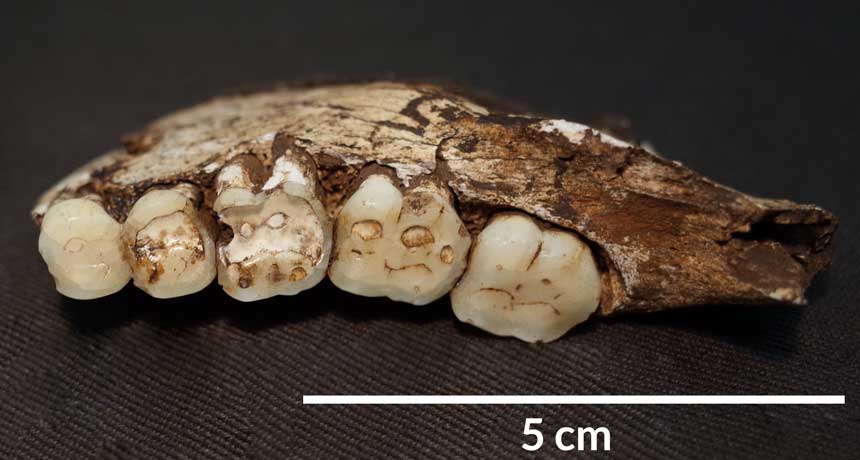Nitty-gritty of Homo naledi’s diet revealed in its teeth

Give Homo naledi credit for originality. The fossils of this humanlike species previously revealed an unexpectedly peculiar body plan. Now its pockmarked teeth speak to an unusually hard-edged diet.
H. naledi displays a much higher rate of chipped teeth than other members of the human evolutionary family that once occupied the same region of South Africa, say biological anthropologist Ian Towle and colleagues. Dental damage of this kind results from frequent biting and chewing on hard or gritty objects, such as raw tubers dug out of the ground, the scientists report in the September American Journal of Physical Anthropology.
“A diet containing hard and resistant foods like nuts and seeds, or contaminants such as grit, is most likely for H. naledi,” says Towle, of Liverpool John Moores University in England.
Extensive tooth chipping shows that “something unusual is going on” with H. naledi’s diet, says paleoanthropologist Peter Ungar of the University of Arkansas in Fayetteville. He directs ongoing microscopic studies of H. naledi’s teeth that may provide clues to what this novel species ate.
Grit from surrounding soil can coat nutrient-rich, underground plant parts, including tubers and roots. Regularly eating those things can cause the type of chipping found on H. naledi teeth, says paleobiologist Paul Constantino of Saint Michael’s College in Colchester, Vt. “Many animals cannot access these underground plants, but primates can, especially if they use digging sticks.”
H. naledi fossils, first found in South Africa’s subterranean Dinaledi Chamber and later a second nearby cave (SN: 6/10/17, p. 6), came from a species that lived between 236,000 and 335,000 years ago. It had a largely humanlike lower body, a relatively small brain and curved fingers suited for climbing trees.
Towle’s group studied 126 of 156 permanent H. naledi teeth found in Dinaledi Chamber. Those finds come from a minimum of 12 individuals, nine of whom had at least one chipped chopper. Two of the remaining three individuals were represented by only one tooth. Teeth excluded from the study were damaged, had not erupted above the gum surface or showed signs of having rarely been used for chewing food.
Chips appear on 56, or about 44 percent, of H. naledi teeth from Dinaledi Chamber, Towle’s team says. Half of those specimens sustained two or more chips. About 54 percent of molars and 44 percent of premolars, both found toward the back of the mouth, display at least one chip. For teeth at the front of the mouth, those figures fell to 25 percent for canines and 33 percent for incisors.
Chewing on small, hard objects must have caused all those chips, Towle says. Using teeth as tools, say to grasp animal hides, mainly damages front teeth, not cheek teeth as in H. naledi. Homemade toothpicks produce marks between teeth unlike those on the H. naledi finds.
Two South African hominids from between roughly 1 million and 3 million years ago, Australopithecus africanus and Paranthropus robustus, show lower rates of tooth chipping than H. naledi, at about 21 percent and 13 percent, respectively, the investigators find. Researchers have suspected for decades that those species ate hard or gritty foods, although ancient menus are difficult to reconstruct (SN: 6/4/11, p. 8). Little evidence exists on the extent of tooth chipping in ancient Homo species. But if H. naledi consumed underground plants, Stone Age Homo sapiens in Africa likely did as well, Constantino says.
In further tooth comparisons with living primates, baboons — consumers of underground plants and hard-shelled fruits — showed the greatest similarity to H. naledi, with fractures on 25 percent of their teeth. That figure reached only about 11 percent in gorillas and 5 percent in chimpanzees.
Human teeth found at sites in Italy, Morocco and the United States show rates and patterns of tooth fractures similar to H. naledi, he adds. Two of those sites date to between 1,000 and 1,700 years ago. The third site, in Morocco, dates to between 11,000 and 12,000 years ago. People at all three sites are suspected to have had diets unusually heavy on gritty or hard-shelled foods, the scientists say.
Chips mar 50 percent of H. naledi’s right teeth, versus 38 percent of its left teeth. That right-side tilt might signify that the Dinaledi crowd were mostly right-handers who typically placed food on the right side of their mouths. But more fossil teeth are needed to evaluate that possibility, Towle cautions.